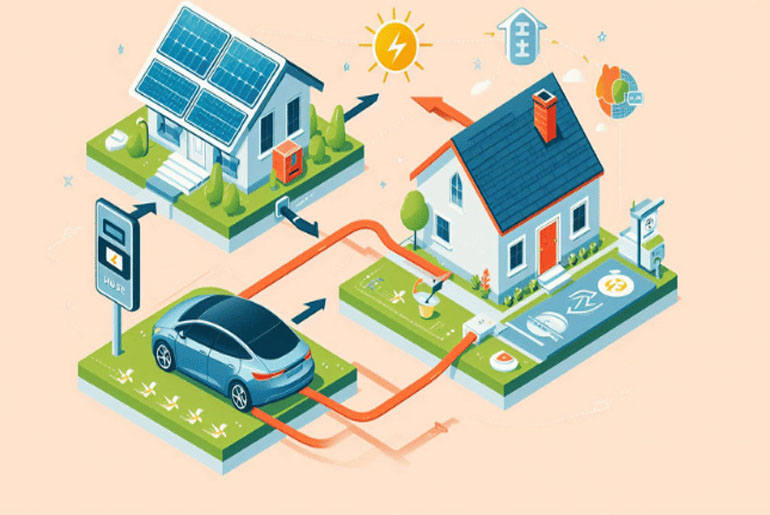As electric vehicles (EVs) proliferate, their integration into the broader energy system becomes increasingly significant. Vehicle-to-Grid (V2G) technology represents a pioneering approach that allows EVs to communicate with the power grid and contribute to energy management. By enabling bidirectional energy flow, V2G technology transforms EVs from mere transportation devices into dynamic energy resources. This article explores the benefits and challenges of V2G technology, highlighting its potential to revolutionize both the automotive and energy sectors.
What is Vehicle-to-Grid (V2G) Technology?
Vehicle-to-Grid (V2G) technology allows electric vehicles to discharge electricity back into the grid. This is achieved through bidirectional chargers that can both charge the EV battery and discharge its stored energy when needed. V2G systems require sophisticated communication and control technologies to manage the energy flow between vehicles and the grid effectively.
Benefits of V2G Technology
-
Grid Stabilization and Energy Storage:
– Demand Response: V2G technology helps stabilize the grid by balancing supply and demand. During peak demand periods, EVs can discharge their stored energy back into the grid, reducing the strain on power plants and mitigating the risk of blackouts.
– Frequency Regulation: V2G can provide ancillary services such as frequency regulation. By responding to real-time fluctuations in grid frequency, EVs can help maintain the stability and reliability of the power supply.
-
Renewable Energy Integration:
– Smoothing Intermittency: One of the challenges with renewable energy sources like solar and wind is their intermittent nature. V2G technology can store excess energy generated during periods of high renewable output and discharge it during low production periods, facilitating a smoother integration of renewables into the energy mix.
– Maximizing Renewable Use: By aligning EV charging with periods of high renewable energy availability, V2G can enhance the utilization of clean energy, reducing reliance on fossil fuels and lowering greenhouse gas emissions.
-
Economic Benefits:
– Revenue Generation: EV owners can earn money by participating in V2G programs. By selling excess energy back to the grid during peak demand periods, they can offset their electricity costs and potentially generate additional income.
– Cost Savings: V2G can reduce the need for expensive grid infrastructure upgrades by utilizing the existing storage capacity of EV batteries, leading to cost savings for utility companies and, ultimately, consumers.
-
Energy Resilience:
– Emergency Backup Power: V2G-equipped EVs can serve as mobile energy storage units, providing backup power during emergencies or grid outages. This capability enhances energy resilience for households and critical infrastructure.
Challenges of V2G Technology
-
Technical and Infrastructure Challenges:
– Bidirectional Chargers: V2G requires specialized bidirectional chargers that are currently more expensive than traditional unidirectional chargers. Widespread adoption of V2G will depend on reducing the cost and increasing the availability of these chargers.
– Battery Degradation: Frequent cycling of batteries for V2G purposes can accelerate battery degradation, potentially reducing the lifespan and performance of EV batteries. Advances in battery technology and management systems are needed to mitigate this issue.
-
Regulatory and Policy Barriers:
– Standardization: The lack of standardized protocols for V2G communication and operation poses a significant barrier. Developing industry-wide standards is crucial to ensure compatibility between different EV models, chargers, and grid systems.
– Regulatory Framework: Current regulatory frameworks may not fully support V2G technology. Policymakers need to create conducive environments that encourage V2G adoption, including incentives for EV owners and utility companies.
-
Economic and Market Considerations:
– Cost-Benefit Analysis: The economic viability of V2G depends on various factors, including electricity prices, battery costs, and grid services compensation. A thorough cost-benefit analysis is necessary to determine the financial feasibility for both EV owners and utility companies.
– Market Participation: For V2G to be successful, there must be sufficient market demand for the services it provides. This requires coordination between EV manufacturers, grid operators, and regulatory bodies to create favorable market conditions.
-
Consumer Acceptance and Awareness:
– Consumer Education: Raising awareness about the benefits and functionality of V2G technology is essential for its widespread adoption. Consumers need to understand how V2G works, its potential economic benefits, and any impacts on vehicle performance.
– Behavioral Change: Adopting V2G may require changes in consumer behavior, such as altering charging habits to align with grid needs. Incentives and user-friendly interfaces can help facilitate this transition.
Future Outlook
Despite the challenges, the future of V2G technology looks promising. Ongoing advancements in battery technology, smart grid infrastructure, and regulatory support are paving the way for broader adoption. Pilot projects and collaborations between automakers, utility companies, and technology providers are demonstrating the viability and benefits of V2G in real-world scenarios.
Innovations such as blockchain technology for secure energy transactions, artificial intelligence for optimizing energy flows, and advancements in vehicle-to-home (V2H) and vehicle-to-building (V2B) applications further expand the potential of V2G systems. As these technologies mature and integrate, V2G is poised to become a critical component of the sustainable energy ecosystem.
Conclusion
Vehicle-to-Grid (V2G) technology offers a transformative approach to energy management by leveraging the storage capacity of electric vehicles. The benefits of grid stabilization, renewable energy integration, economic opportunities, and enhanced energy resilience underscore its potential to revolutionize both the automotive and energy sectors. However, technical, regulatory, economic, and consumer-related challenges must be addressed to realize its full potential. With continued innovation, collaboration, and supportive policies, V2G technology can play a pivotal role in the transition to a cleaner, more efficient, and resilient energy future.

